Pressure Ulcer Prevention: Learning for Professional Development Study
VerifiedAdded on 2023/01/19
|10
|3236
|70
Report
AI Summary
This report delves into the critical area of pressure ulcer prevention, drawing on two primary studies: one focusing on two-hourly repositioning in elderly patients and another examining nurses' knowledge in Wollega public hospitals. It identifies key findings from each study, comparing and contrasting their insights on preventive measures, challenges in clinical practice such as lack of skilled workforce and resources, and the importance of training. The report also reflects on the evidence presented, emphasizing the significance of repositioning techniques, skin assessment, and the need for comprehensive educational programs for nurses. Ultimately, the analysis underscores the importance of integrating research findings into clinical practice to improve patient outcomes and reduce the incidence of pressure ulcers, providing valuable insights for professional development in nursing and healthcare, get more solved assignments on Desklib.
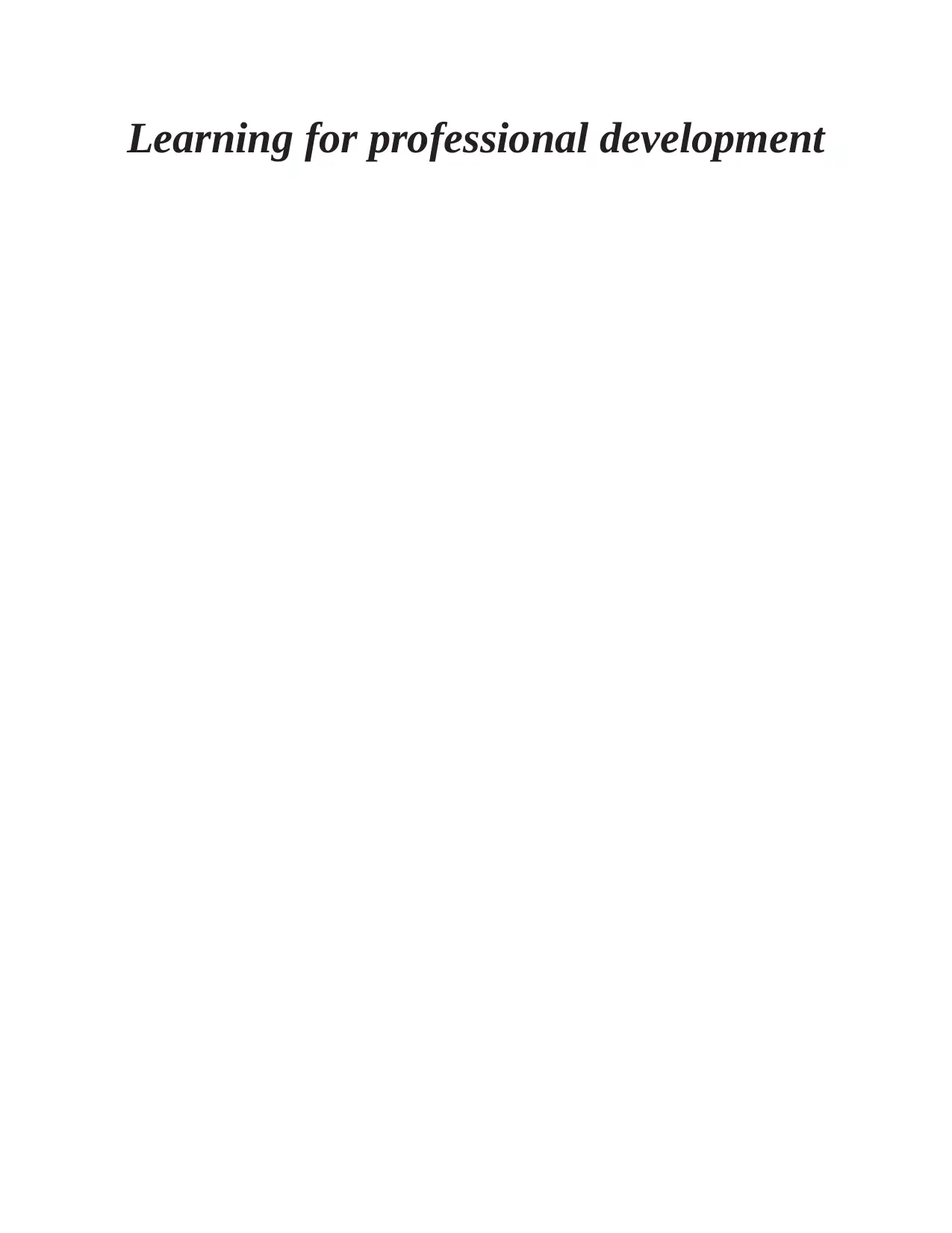
Learning for professional development
Paraphrase This Document
Need a fresh take? Get an instant paraphrase of this document with our AI Paraphraser
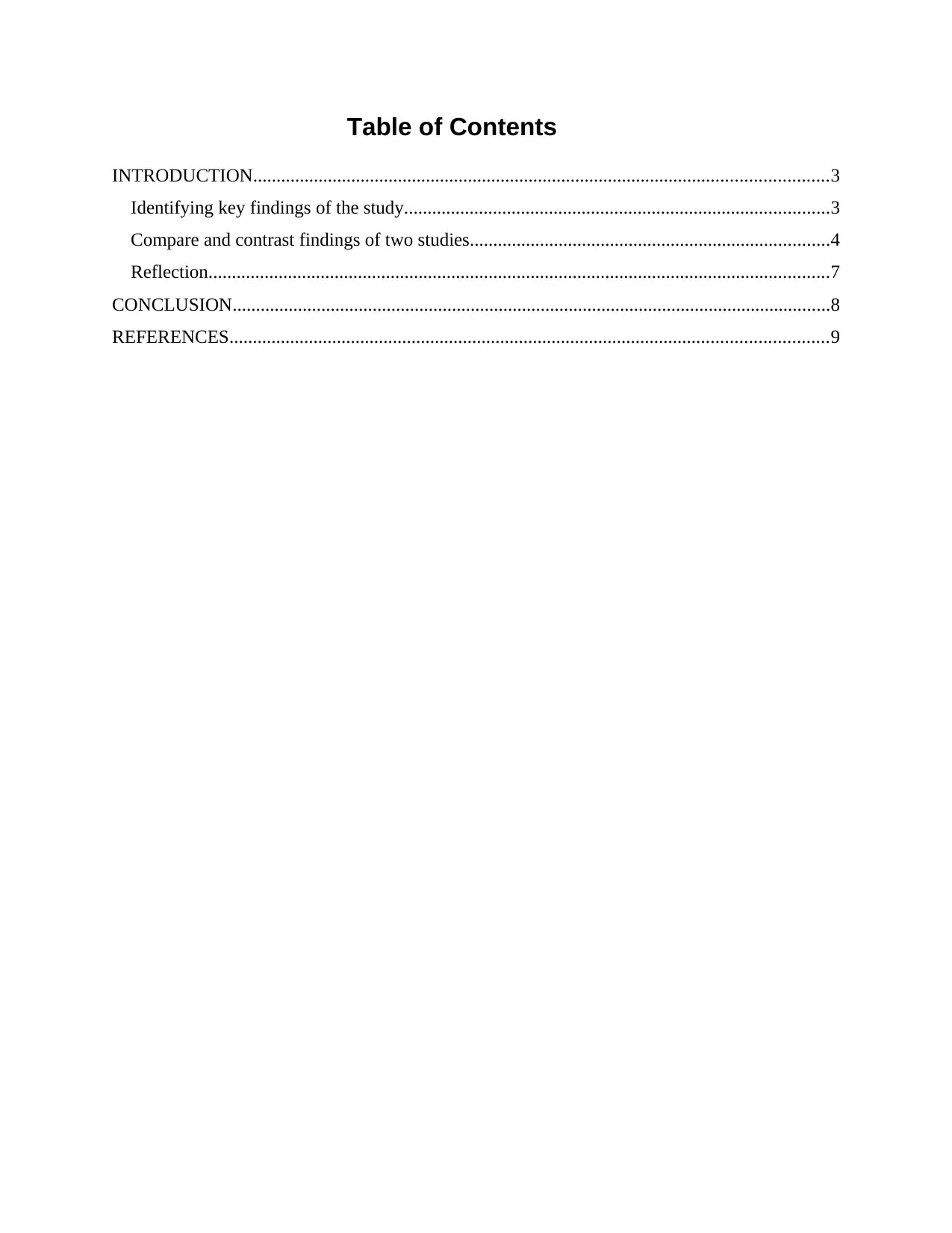
Table of Contents
INTRODUCTION...........................................................................................................................3
Identifying key findings of the study...........................................................................................3
Compare and contrast findings of two studies.............................................................................4
Reflection.....................................................................................................................................7
CONCLUSION................................................................................................................................8
REFERENCES................................................................................................................................9
INTRODUCTION...........................................................................................................................3
Identifying key findings of the study...........................................................................................3
Compare and contrast findings of two studies.............................................................................4
Reflection.....................................................................................................................................7
CONCLUSION................................................................................................................................8
REFERENCES................................................................................................................................9
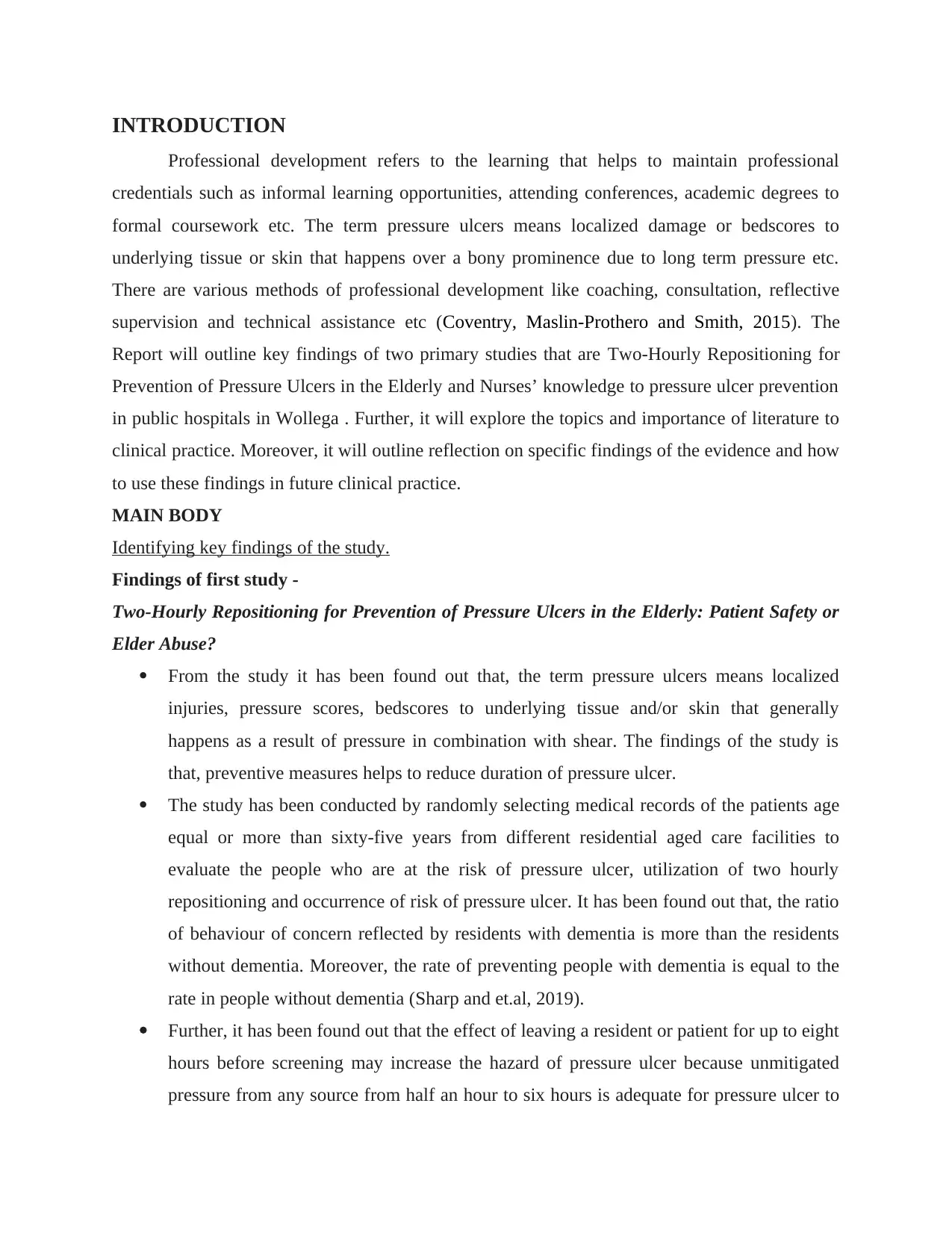
INTRODUCTION
Professional development refers to the learning that helps to maintain professional
credentials such as informal learning opportunities, attending conferences, academic degrees to
formal coursework etc. The term pressure ulcers means localized damage or bedscores to
underlying tissue or skin that happens over a bony prominence due to long term pressure etc.
There are various methods of professional development like coaching, consultation, reflective
supervision and technical assistance etc (Coventry, Maslin‐Prothero and Smith, 2015). The
Report will outline key findings of two primary studies that are Two-Hourly Repositioning for
Prevention of Pressure Ulcers in the Elderly and Nurses’ knowledge to pressure ulcer prevention
in public hospitals in Wollega . Further, it will explore the topics and importance of literature to
clinical practice. Moreover, it will outline reflection on specific findings of the evidence and how
to use these findings in future clinical practice.
MAIN BODY
Identifying key findings of the study.
Findings of first study -
Two-Hourly Repositioning for Prevention of Pressure Ulcers in the Elderly: Patient Safety or
Elder Abuse?
From the study it has been found out that, the term pressure ulcers means localized
injuries, pressure scores, bedscores to underlying tissue and/or skin that generally
happens as a result of pressure in combination with shear. The findings of the study is
that, preventive measures helps to reduce duration of pressure ulcer.
The study has been conducted by randomly selecting medical records of the patients age
equal or more than sixty-five years from different residential aged care facilities to
evaluate the people who are at the risk of pressure ulcer, utilization of two hourly
repositioning and occurrence of risk of pressure ulcer. It has been found out that, the ratio
of behaviour of concern reflected by residents with dementia is more than the residents
without dementia. Moreover, the rate of preventing people with dementia is equal to the
rate in people without dementia (Sharp and et.al, 2019).
Further, it has been found out that the effect of leaving a resident or patient for up to eight
hours before screening may increase the hazard of pressure ulcer because unmitigated
pressure from any source from half an hour to six hours is adequate for pressure ulcer to
Professional development refers to the learning that helps to maintain professional
credentials such as informal learning opportunities, attending conferences, academic degrees to
formal coursework etc. The term pressure ulcers means localized damage or bedscores to
underlying tissue or skin that happens over a bony prominence due to long term pressure etc.
There are various methods of professional development like coaching, consultation, reflective
supervision and technical assistance etc (Coventry, Maslin‐Prothero and Smith, 2015). The
Report will outline key findings of two primary studies that are Two-Hourly Repositioning for
Prevention of Pressure Ulcers in the Elderly and Nurses’ knowledge to pressure ulcer prevention
in public hospitals in Wollega . Further, it will explore the topics and importance of literature to
clinical practice. Moreover, it will outline reflection on specific findings of the evidence and how
to use these findings in future clinical practice.
MAIN BODY
Identifying key findings of the study.
Findings of first study -
Two-Hourly Repositioning for Prevention of Pressure Ulcers in the Elderly: Patient Safety or
Elder Abuse?
From the study it has been found out that, the term pressure ulcers means localized
injuries, pressure scores, bedscores to underlying tissue and/or skin that generally
happens as a result of pressure in combination with shear. The findings of the study is
that, preventive measures helps to reduce duration of pressure ulcer.
The study has been conducted by randomly selecting medical records of the patients age
equal or more than sixty-five years from different residential aged care facilities to
evaluate the people who are at the risk of pressure ulcer, utilization of two hourly
repositioning and occurrence of risk of pressure ulcer. It has been found out that, the ratio
of behaviour of concern reflected by residents with dementia is more than the residents
without dementia. Moreover, the rate of preventing people with dementia is equal to the
rate in people without dementia (Sharp and et.al, 2019).
Further, it has been found out that the effect of leaving a resident or patient for up to eight
hours before screening may increase the hazard of pressure ulcer because unmitigated
pressure from any source from half an hour to six hours is adequate for pressure ulcer to
⊘ This is a preview!⊘
Do you want full access?
Subscribe today to unlock all pages.

Trusted by 1+ million students worldwide
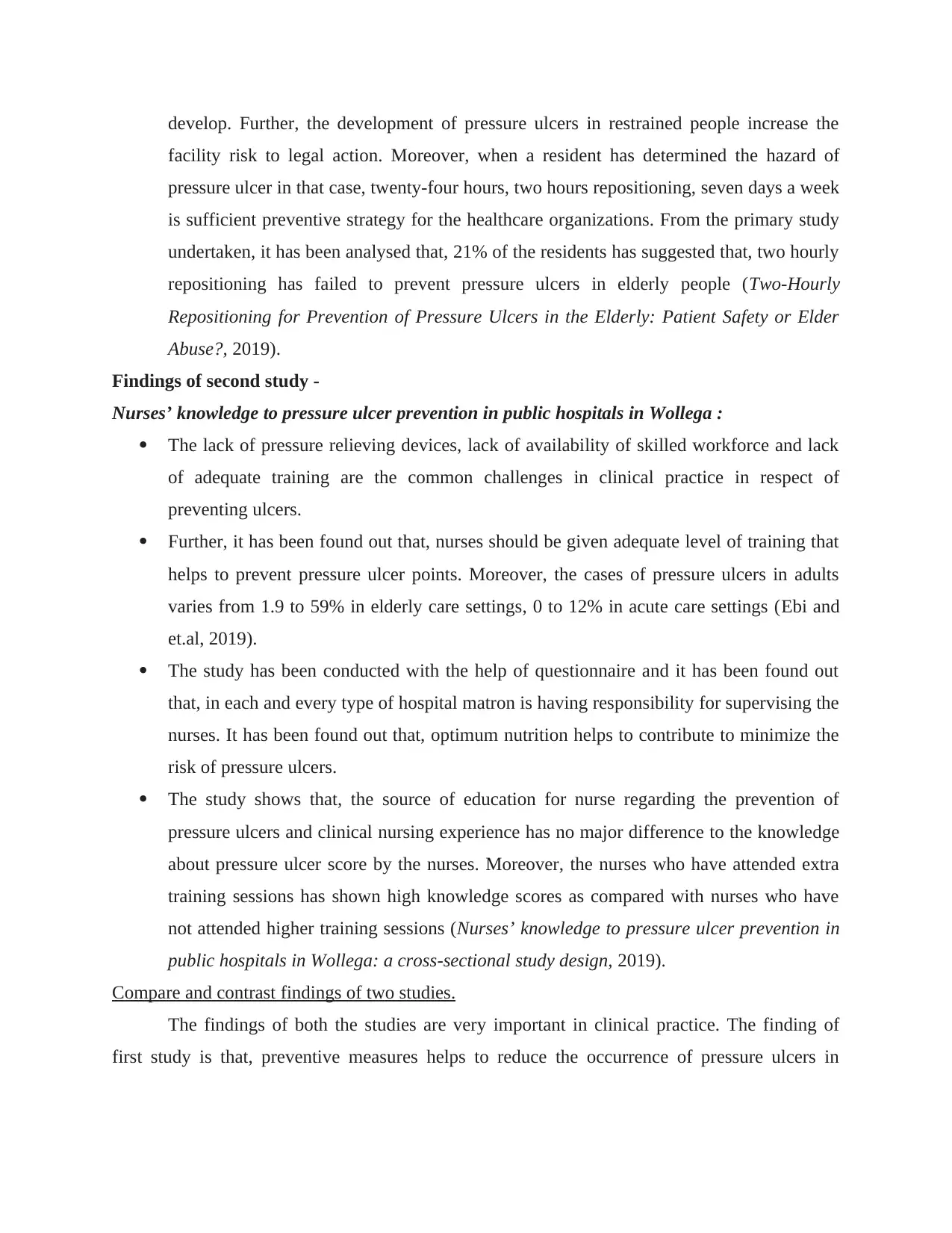
develop. Further, the development of pressure ulcers in restrained people increase the
facility risk to legal action. Moreover, when a resident has determined the hazard of
pressure ulcer in that case, twenty-four hours, two hours repositioning, seven days a week
is sufficient preventive strategy for the healthcare organizations. From the primary study
undertaken, it has been analysed that, 21% of the residents has suggested that, two hourly
repositioning has failed to prevent pressure ulcers in elderly people (Two-Hourly
Repositioning for Prevention of Pressure Ulcers in the Elderly: Patient Safety or Elder
Abuse?, 2019).
Findings of second study -
Nurses’ knowledge to pressure ulcer prevention in public hospitals in Wollega :
The lack of pressure relieving devices, lack of availability of skilled workforce and lack
of adequate training are the common challenges in clinical practice in respect of
preventing ulcers.
Further, it has been found out that, nurses should be given adequate level of training that
helps to prevent pressure ulcer points. Moreover, the cases of pressure ulcers in adults
varies from 1.9 to 59% in elderly care settings, 0 to 12% in acute care settings (Ebi and
et.al, 2019).
The study has been conducted with the help of questionnaire and it has been found out
that, in each and every type of hospital matron is having responsibility for supervising the
nurses. It has been found out that, optimum nutrition helps to contribute to minimize the
risk of pressure ulcers.
The study shows that, the source of education for nurse regarding the prevention of
pressure ulcers and clinical nursing experience has no major difference to the knowledge
about pressure ulcer score by the nurses. Moreover, the nurses who have attended extra
training sessions has shown high knowledge scores as compared with nurses who have
not attended higher training sessions (Nurses’ knowledge to pressure ulcer prevention in
public hospitals in Wollega: a cross-sectional study design, 2019).
Compare and contrast findings of two studies.
The findings of both the studies are very important in clinical practice. The finding of
first study is that, preventive measures helps to reduce the occurrence of pressure ulcers in
facility risk to legal action. Moreover, when a resident has determined the hazard of
pressure ulcer in that case, twenty-four hours, two hours repositioning, seven days a week
is sufficient preventive strategy for the healthcare organizations. From the primary study
undertaken, it has been analysed that, 21% of the residents has suggested that, two hourly
repositioning has failed to prevent pressure ulcers in elderly people (Two-Hourly
Repositioning for Prevention of Pressure Ulcers in the Elderly: Patient Safety or Elder
Abuse?, 2019).
Findings of second study -
Nurses’ knowledge to pressure ulcer prevention in public hospitals in Wollega :
The lack of pressure relieving devices, lack of availability of skilled workforce and lack
of adequate training are the common challenges in clinical practice in respect of
preventing ulcers.
Further, it has been found out that, nurses should be given adequate level of training that
helps to prevent pressure ulcer points. Moreover, the cases of pressure ulcers in adults
varies from 1.9 to 59% in elderly care settings, 0 to 12% in acute care settings (Ebi and
et.al, 2019).
The study has been conducted with the help of questionnaire and it has been found out
that, in each and every type of hospital matron is having responsibility for supervising the
nurses. It has been found out that, optimum nutrition helps to contribute to minimize the
risk of pressure ulcers.
The study shows that, the source of education for nurse regarding the prevention of
pressure ulcers and clinical nursing experience has no major difference to the knowledge
about pressure ulcer score by the nurses. Moreover, the nurses who have attended extra
training sessions has shown high knowledge scores as compared with nurses who have
not attended higher training sessions (Nurses’ knowledge to pressure ulcer prevention in
public hospitals in Wollega: a cross-sectional study design, 2019).
Compare and contrast findings of two studies.
The findings of both the studies are very important in clinical practice. The finding of
first study is that, preventive measures helps to reduce the occurrence of pressure ulcers in
Paraphrase This Document
Need a fresh take? Get an instant paraphrase of this document with our AI Paraphraser
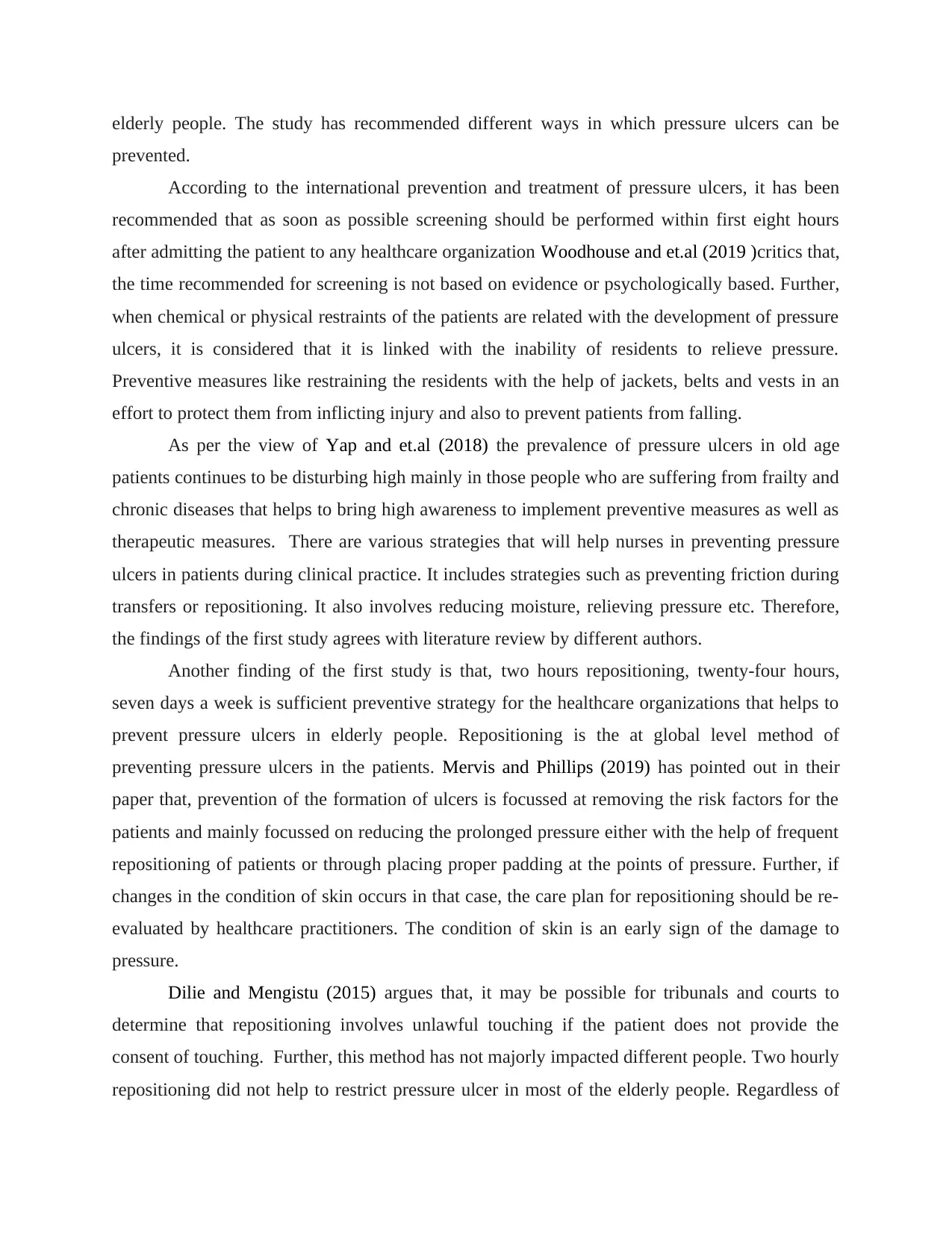
elderly people. The study has recommended different ways in which pressure ulcers can be
prevented.
According to the international prevention and treatment of pressure ulcers, it has been
recommended that as soon as possible screening should be performed within first eight hours
after admitting the patient to any healthcare organization Woodhouse and et.al (2019 )critics that,
the time recommended for screening is not based on evidence or psychologically based. Further,
when chemical or physical restraints of the patients are related with the development of pressure
ulcers, it is considered that it is linked with the inability of residents to relieve pressure.
Preventive measures like restraining the residents with the help of jackets, belts and vests in an
effort to protect them from inflicting injury and also to prevent patients from falling.
As per the view of Yap and et.al (2018) the prevalence of pressure ulcers in old age
patients continues to be disturbing high mainly in those people who are suffering from frailty and
chronic diseases that helps to bring high awareness to implement preventive measures as well as
therapeutic measures. There are various strategies that will help nurses in preventing pressure
ulcers in patients during clinical practice. It includes strategies such as preventing friction during
transfers or repositioning. It also involves reducing moisture, relieving pressure etc. Therefore,
the findings of the first study agrees with literature review by different authors.
Another finding of the first study is that, two hours repositioning, twenty-four hours,
seven days a week is sufficient preventive strategy for the healthcare organizations that helps to
prevent pressure ulcers in elderly people. Repositioning is the at global level method of
preventing pressure ulcers in the patients. Mervis and Phillips (2019) has pointed out in their
paper that, prevention of the formation of ulcers is focussed at removing the risk factors for the
patients and mainly focussed on reducing the prolonged pressure either with the help of frequent
repositioning of patients or through placing proper padding at the points of pressure. Further, if
changes in the condition of skin occurs in that case, the care plan for repositioning should be re-
evaluated by healthcare practitioners. The condition of skin is an early sign of the damage to
pressure.
Dilie and Mengistu (2015) argues that, it may be possible for tribunals and courts to
determine that repositioning involves unlawful touching if the patient does not provide the
consent of touching. Further, this method has not majorly impacted different people. Two hourly
repositioning did not help to restrict pressure ulcer in most of the elderly people. Regardless of
prevented.
According to the international prevention and treatment of pressure ulcers, it has been
recommended that as soon as possible screening should be performed within first eight hours
after admitting the patient to any healthcare organization Woodhouse and et.al (2019 )critics that,
the time recommended for screening is not based on evidence or psychologically based. Further,
when chemical or physical restraints of the patients are related with the development of pressure
ulcers, it is considered that it is linked with the inability of residents to relieve pressure.
Preventive measures like restraining the residents with the help of jackets, belts and vests in an
effort to protect them from inflicting injury and also to prevent patients from falling.
As per the view of Yap and et.al (2018) the prevalence of pressure ulcers in old age
patients continues to be disturbing high mainly in those people who are suffering from frailty and
chronic diseases that helps to bring high awareness to implement preventive measures as well as
therapeutic measures. There are various strategies that will help nurses in preventing pressure
ulcers in patients during clinical practice. It includes strategies such as preventing friction during
transfers or repositioning. It also involves reducing moisture, relieving pressure etc. Therefore,
the findings of the first study agrees with literature review by different authors.
Another finding of the first study is that, two hours repositioning, twenty-four hours,
seven days a week is sufficient preventive strategy for the healthcare organizations that helps to
prevent pressure ulcers in elderly people. Repositioning is the at global level method of
preventing pressure ulcers in the patients. Mervis and Phillips (2019) has pointed out in their
paper that, prevention of the formation of ulcers is focussed at removing the risk factors for the
patients and mainly focussed on reducing the prolonged pressure either with the help of frequent
repositioning of patients or through placing proper padding at the points of pressure. Further, if
changes in the condition of skin occurs in that case, the care plan for repositioning should be re-
evaluated by healthcare practitioners. The condition of skin is an early sign of the damage to
pressure.
Dilie and Mengistu (2015) argues that, it may be possible for tribunals and courts to
determine that repositioning involves unlawful touching if the patient does not provide the
consent of touching. Further, this method has not majorly impacted different people. Two hourly
repositioning did not help to restrict pressure ulcer in most of the elderly people. Regardless of
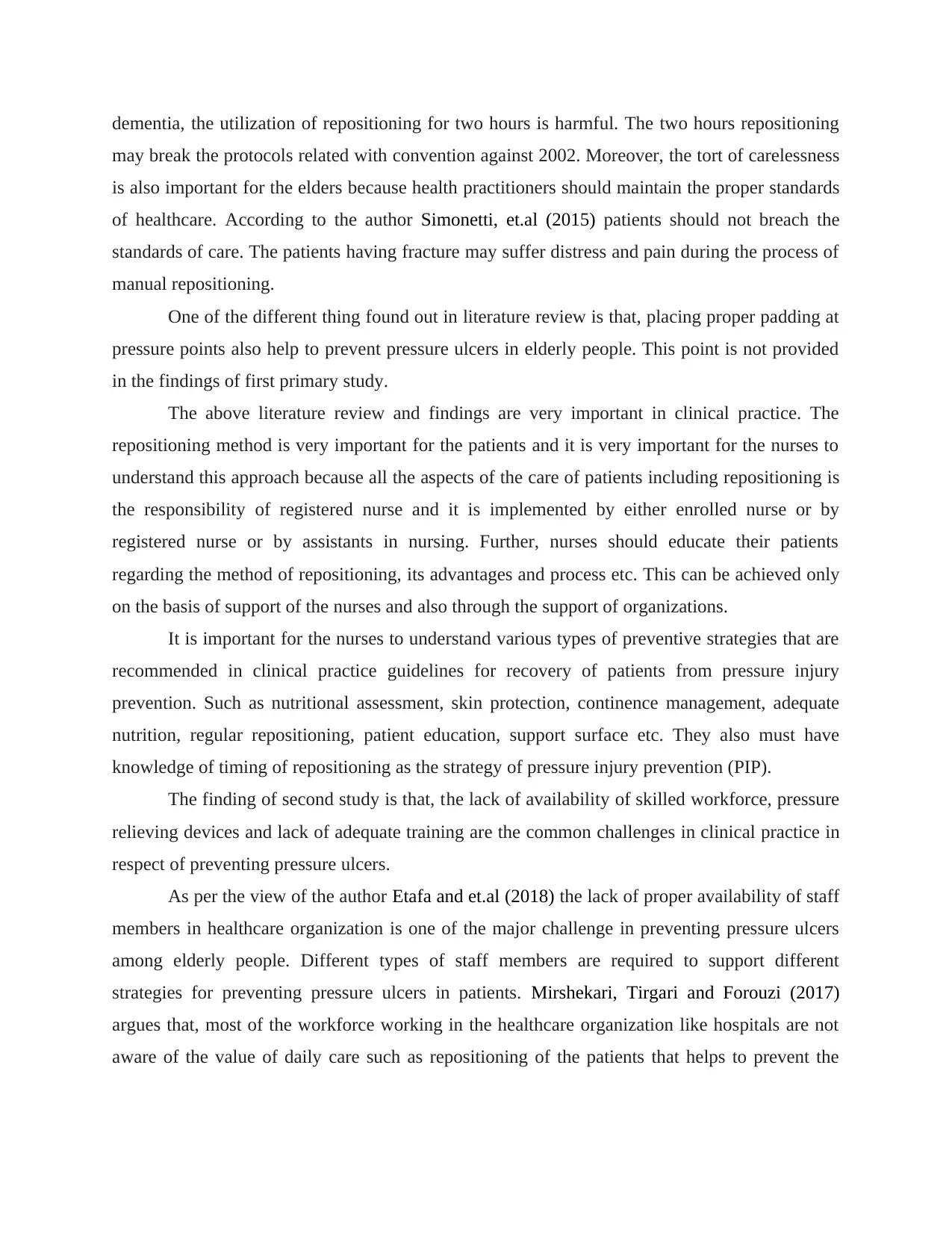
dementia, the utilization of repositioning for two hours is harmful. The two hours repositioning
may break the protocols related with convention against 2002. Moreover, the tort of carelessness
is also important for the elders because health practitioners should maintain the proper standards
of healthcare. According to the author Simonetti, et.al (2015) patients should not breach the
standards of care. The patients having fracture may suffer distress and pain during the process of
manual repositioning.
One of the different thing found out in literature review is that, placing proper padding at
pressure points also help to prevent pressure ulcers in elderly people. This point is not provided
in the findings of first primary study.
The above literature review and findings are very important in clinical practice. The
repositioning method is very important for the patients and it is very important for the nurses to
understand this approach because all the aspects of the care of patients including repositioning is
the responsibility of registered nurse and it is implemented by either enrolled nurse or by
registered nurse or by assistants in nursing. Further, nurses should educate their patients
regarding the method of repositioning, its advantages and process etc. This can be achieved only
on the basis of support of the nurses and also through the support of organizations.
It is important for the nurses to understand various types of preventive strategies that are
recommended in clinical practice guidelines for recovery of patients from pressure injury
prevention. Such as nutritional assessment, skin protection, continence management, adequate
nutrition, regular repositioning, patient education, support surface etc. They also must have
knowledge of timing of repositioning as the strategy of pressure injury prevention (PIP).
The finding of second study is that, the lack of availability of skilled workforce, pressure
relieving devices and lack of adequate training are the common challenges in clinical practice in
respect of preventing pressure ulcers.
As per the view of the author Etafa and et.al (2018) the lack of proper availability of staff
members in healthcare organization is one of the major challenge in preventing pressure ulcers
among elderly people. Different types of staff members are required to support different
strategies for preventing pressure ulcers in patients. Mirshekari, Tirgari and Forouzi (2017)
argues that, most of the workforce working in the healthcare organization like hospitals are not
aware of the value of daily care such as repositioning of the patients that helps to prevent the
may break the protocols related with convention against 2002. Moreover, the tort of carelessness
is also important for the elders because health practitioners should maintain the proper standards
of healthcare. According to the author Simonetti, et.al (2015) patients should not breach the
standards of care. The patients having fracture may suffer distress and pain during the process of
manual repositioning.
One of the different thing found out in literature review is that, placing proper padding at
pressure points also help to prevent pressure ulcers in elderly people. This point is not provided
in the findings of first primary study.
The above literature review and findings are very important in clinical practice. The
repositioning method is very important for the patients and it is very important for the nurses to
understand this approach because all the aspects of the care of patients including repositioning is
the responsibility of registered nurse and it is implemented by either enrolled nurse or by
registered nurse or by assistants in nursing. Further, nurses should educate their patients
regarding the method of repositioning, its advantages and process etc. This can be achieved only
on the basis of support of the nurses and also through the support of organizations.
It is important for the nurses to understand various types of preventive strategies that are
recommended in clinical practice guidelines for recovery of patients from pressure injury
prevention. Such as nutritional assessment, skin protection, continence management, adequate
nutrition, regular repositioning, patient education, support surface etc. They also must have
knowledge of timing of repositioning as the strategy of pressure injury prevention (PIP).
The finding of second study is that, the lack of availability of skilled workforce, pressure
relieving devices and lack of adequate training are the common challenges in clinical practice in
respect of preventing pressure ulcers.
As per the view of the author Etafa and et.al (2018) the lack of proper availability of staff
members in healthcare organization is one of the major challenge in preventing pressure ulcers
among elderly people. Different types of staff members are required to support different
strategies for preventing pressure ulcers in patients. Mirshekari, Tirgari and Forouzi (2017)
argues that, most of the workforce working in the healthcare organization like hospitals are not
aware of the value of daily care such as repositioning of the patients that helps to prevent the
⊘ This is a preview!⊘
Do you want full access?
Subscribe today to unlock all pages.

Trusted by 1+ million students worldwide
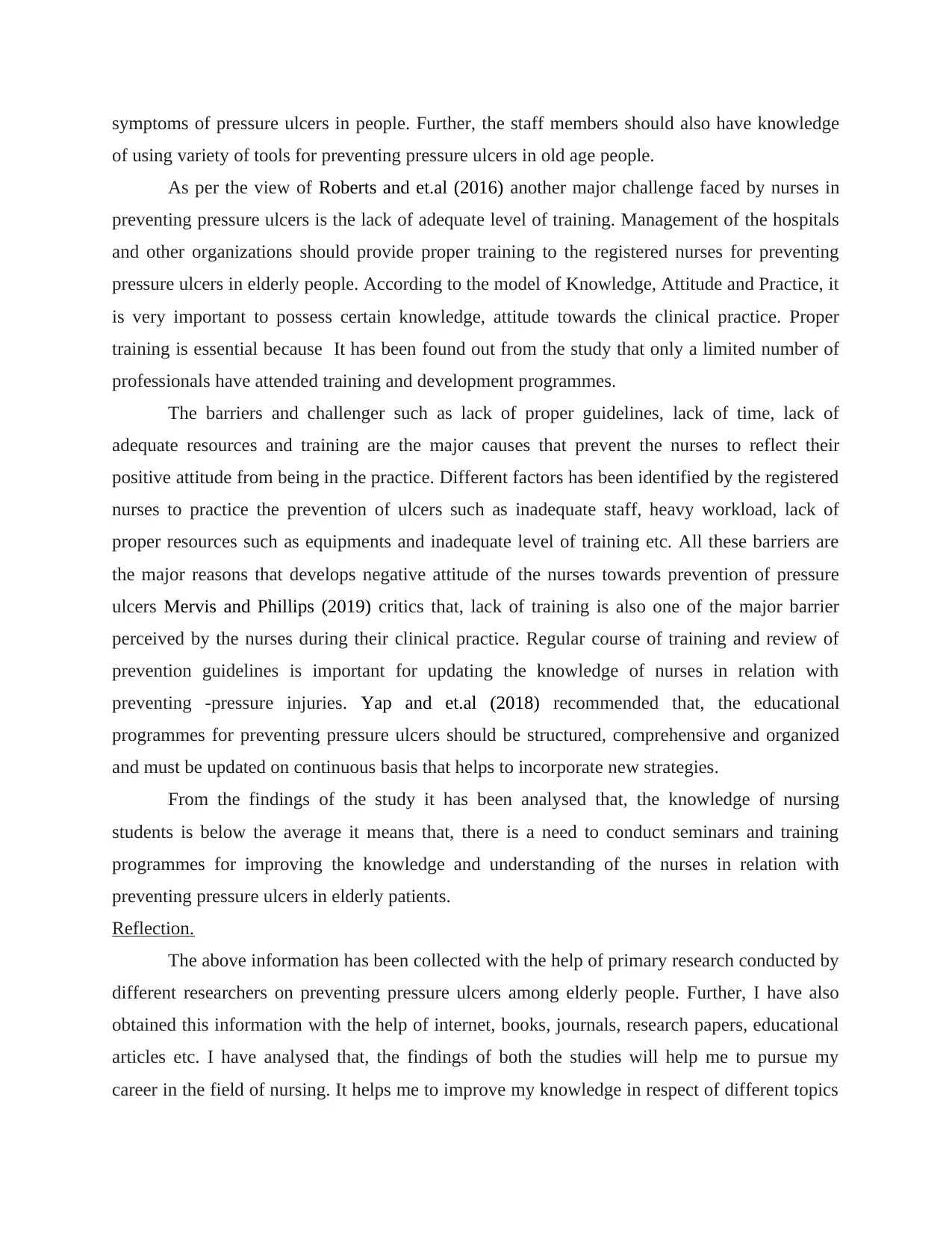
symptoms of pressure ulcers in people. Further, the staff members should also have knowledge
of using variety of tools for preventing pressure ulcers in old age people.
As per the view of Roberts and et.al (2016) another major challenge faced by nurses in
preventing pressure ulcers is the lack of adequate level of training. Management of the hospitals
and other organizations should provide proper training to the registered nurses for preventing
pressure ulcers in elderly people. According to the model of Knowledge, Attitude and Practice, it
is very important to possess certain knowledge, attitude towards the clinical practice. Proper
training is essential because It has been found out from the study that only a limited number of
professionals have attended training and development programmes.
The barriers and challenger such as lack of proper guidelines, lack of time, lack of
adequate resources and training are the major causes that prevent the nurses to reflect their
positive attitude from being in the practice. Different factors has been identified by the registered
nurses to practice the prevention of ulcers such as inadequate staff, heavy workload, lack of
proper resources such as equipments and inadequate level of training etc. All these barriers are
the major reasons that develops negative attitude of the nurses towards prevention of pressure
ulcers Mervis and Phillips (2019) critics that, lack of training is also one of the major barrier
perceived by the nurses during their clinical practice. Regular course of training and review of
prevention guidelines is important for updating the knowledge of nurses in relation with
preventing -pressure injuries. Yap and et.al (2018) recommended that, the educational
programmes for preventing pressure ulcers should be structured, comprehensive and organized
and must be updated on continuous basis that helps to incorporate new strategies.
From the findings of the study it has been analysed that, the knowledge of nursing
students is below the average it means that, there is a need to conduct seminars and training
programmes for improving the knowledge and understanding of the nurses in relation with
preventing pressure ulcers in elderly patients.
Reflection.
The above information has been collected with the help of primary research conducted by
different researchers on preventing pressure ulcers among elderly people. Further, I have also
obtained this information with the help of internet, books, journals, research papers, educational
articles etc. I have analysed that, the findings of both the studies will help me to pursue my
career in the field of nursing. It helps me to improve my knowledge in respect of different topics
of using variety of tools for preventing pressure ulcers in old age people.
As per the view of Roberts and et.al (2016) another major challenge faced by nurses in
preventing pressure ulcers is the lack of adequate level of training. Management of the hospitals
and other organizations should provide proper training to the registered nurses for preventing
pressure ulcers in elderly people. According to the model of Knowledge, Attitude and Practice, it
is very important to possess certain knowledge, attitude towards the clinical practice. Proper
training is essential because It has been found out from the study that only a limited number of
professionals have attended training and development programmes.
The barriers and challenger such as lack of proper guidelines, lack of time, lack of
adequate resources and training are the major causes that prevent the nurses to reflect their
positive attitude from being in the practice. Different factors has been identified by the registered
nurses to practice the prevention of ulcers such as inadequate staff, heavy workload, lack of
proper resources such as equipments and inadequate level of training etc. All these barriers are
the major reasons that develops negative attitude of the nurses towards prevention of pressure
ulcers Mervis and Phillips (2019) critics that, lack of training is also one of the major barrier
perceived by the nurses during their clinical practice. Regular course of training and review of
prevention guidelines is important for updating the knowledge of nurses in relation with
preventing -pressure injuries. Yap and et.al (2018) recommended that, the educational
programmes for preventing pressure ulcers should be structured, comprehensive and organized
and must be updated on continuous basis that helps to incorporate new strategies.
From the findings of the study it has been analysed that, the knowledge of nursing
students is below the average it means that, there is a need to conduct seminars and training
programmes for improving the knowledge and understanding of the nurses in relation with
preventing pressure ulcers in elderly patients.
Reflection.
The above information has been collected with the help of primary research conducted by
different researchers on preventing pressure ulcers among elderly people. Further, I have also
obtained this information with the help of internet, books, journals, research papers, educational
articles etc. I have analysed that, the findings of both the studies will help me to pursue my
career in the field of nursing. It helps me to improve my knowledge in respect of different topics
Paraphrase This Document
Need a fresh take? Get an instant paraphrase of this document with our AI Paraphraser
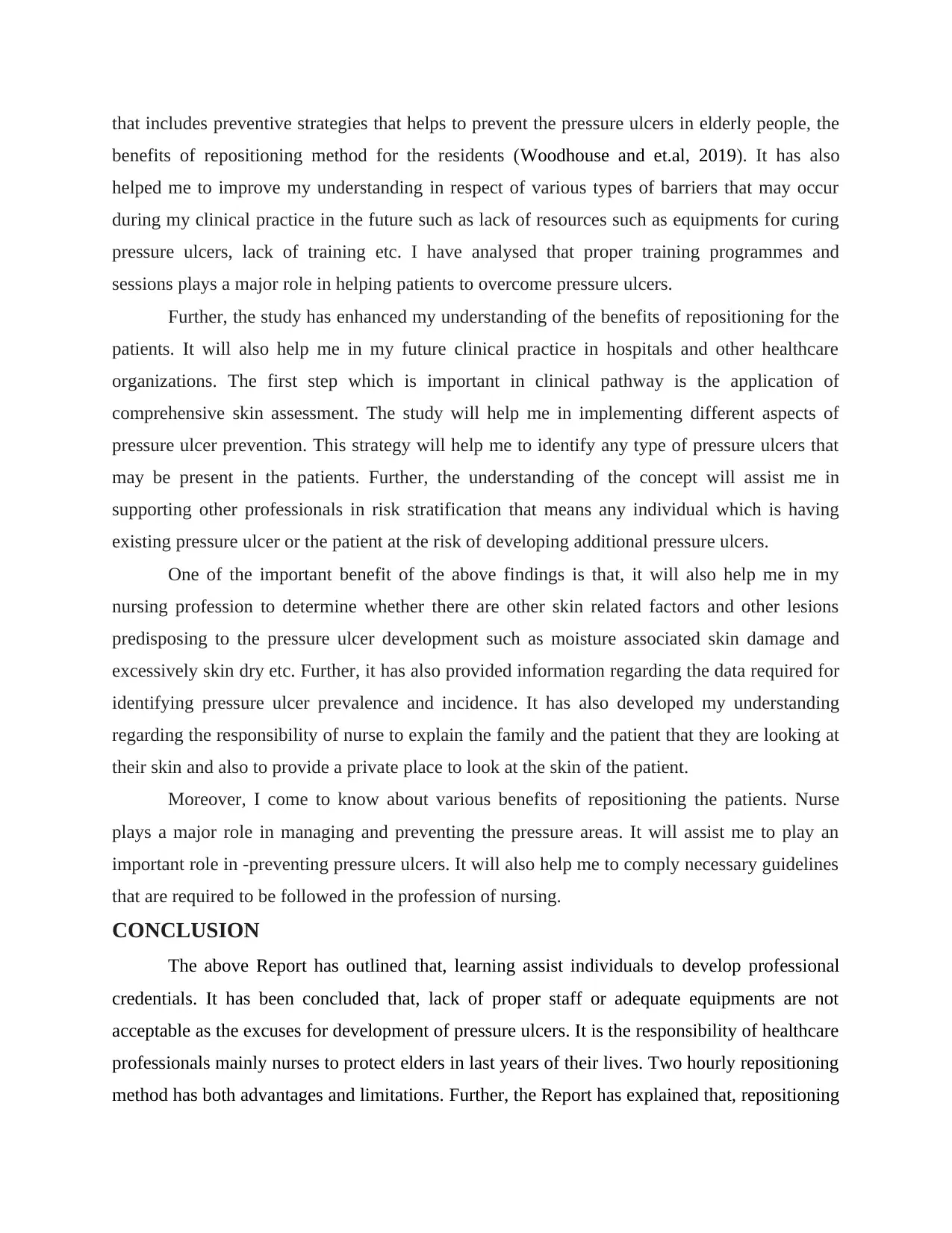
that includes preventive strategies that helps to prevent the pressure ulcers in elderly people, the
benefits of repositioning method for the residents (Woodhouse and et.al, 2019). It has also
helped me to improve my understanding in respect of various types of barriers that may occur
during my clinical practice in the future such as lack of resources such as equipments for curing
pressure ulcers, lack of training etc. I have analysed that proper training programmes and
sessions plays a major role in helping patients to overcome pressure ulcers.
Further, the study has enhanced my understanding of the benefits of repositioning for the
patients. It will also help me in my future clinical practice in hospitals and other healthcare
organizations. The first step which is important in clinical pathway is the application of
comprehensive skin assessment. The study will help me in implementing different aspects of
pressure ulcer prevention. This strategy will help me to identify any type of pressure ulcers that
may be present in the patients. Further, the understanding of the concept will assist me in
supporting other professionals in risk stratification that means any individual which is having
existing pressure ulcer or the patient at the risk of developing additional pressure ulcers.
One of the important benefit of the above findings is that, it will also help me in my
nursing profession to determine whether there are other skin related factors and other lesions
predisposing to the pressure ulcer development such as moisture associated skin damage and
excessively skin dry etc. Further, it has also provided information regarding the data required for
identifying pressure ulcer prevalence and incidence. It has also developed my understanding
regarding the responsibility of nurse to explain the family and the patient that they are looking at
their skin and also to provide a private place to look at the skin of the patient.
Moreover, I come to know about various benefits of repositioning the patients. Nurse
plays a major role in managing and preventing the pressure areas. It will assist me to play an
important role in -preventing pressure ulcers. It will also help me to comply necessary guidelines
that are required to be followed in the profession of nursing.
CONCLUSION
The above Report has outlined that, learning assist individuals to develop professional
credentials. It has been concluded that, lack of proper staff or adequate equipments are not
acceptable as the excuses for development of pressure ulcers. It is the responsibility of healthcare
professionals mainly nurses to protect elders in last years of their lives. Two hourly repositioning
method has both advantages and limitations. Further, the Report has explained that, repositioning
benefits of repositioning method for the residents (Woodhouse and et.al, 2019). It has also
helped me to improve my understanding in respect of various types of barriers that may occur
during my clinical practice in the future such as lack of resources such as equipments for curing
pressure ulcers, lack of training etc. I have analysed that proper training programmes and
sessions plays a major role in helping patients to overcome pressure ulcers.
Further, the study has enhanced my understanding of the benefits of repositioning for the
patients. It will also help me in my future clinical practice in hospitals and other healthcare
organizations. The first step which is important in clinical pathway is the application of
comprehensive skin assessment. The study will help me in implementing different aspects of
pressure ulcer prevention. This strategy will help me to identify any type of pressure ulcers that
may be present in the patients. Further, the understanding of the concept will assist me in
supporting other professionals in risk stratification that means any individual which is having
existing pressure ulcer or the patient at the risk of developing additional pressure ulcers.
One of the important benefit of the above findings is that, it will also help me in my
nursing profession to determine whether there are other skin related factors and other lesions
predisposing to the pressure ulcer development such as moisture associated skin damage and
excessively skin dry etc. Further, it has also provided information regarding the data required for
identifying pressure ulcer prevalence and incidence. It has also developed my understanding
regarding the responsibility of nurse to explain the family and the patient that they are looking at
their skin and also to provide a private place to look at the skin of the patient.
Moreover, I come to know about various benefits of repositioning the patients. Nurse
plays a major role in managing and preventing the pressure areas. It will assist me to play an
important role in -preventing pressure ulcers. It will also help me to comply necessary guidelines
that are required to be followed in the profession of nursing.
CONCLUSION
The above Report has outlined that, learning assist individuals to develop professional
credentials. It has been concluded that, lack of proper staff or adequate equipments are not
acceptable as the excuses for development of pressure ulcers. It is the responsibility of healthcare
professionals mainly nurses to protect elders in last years of their lives. Two hourly repositioning
method has both advantages and limitations. Further, the Report has explained that, repositioning
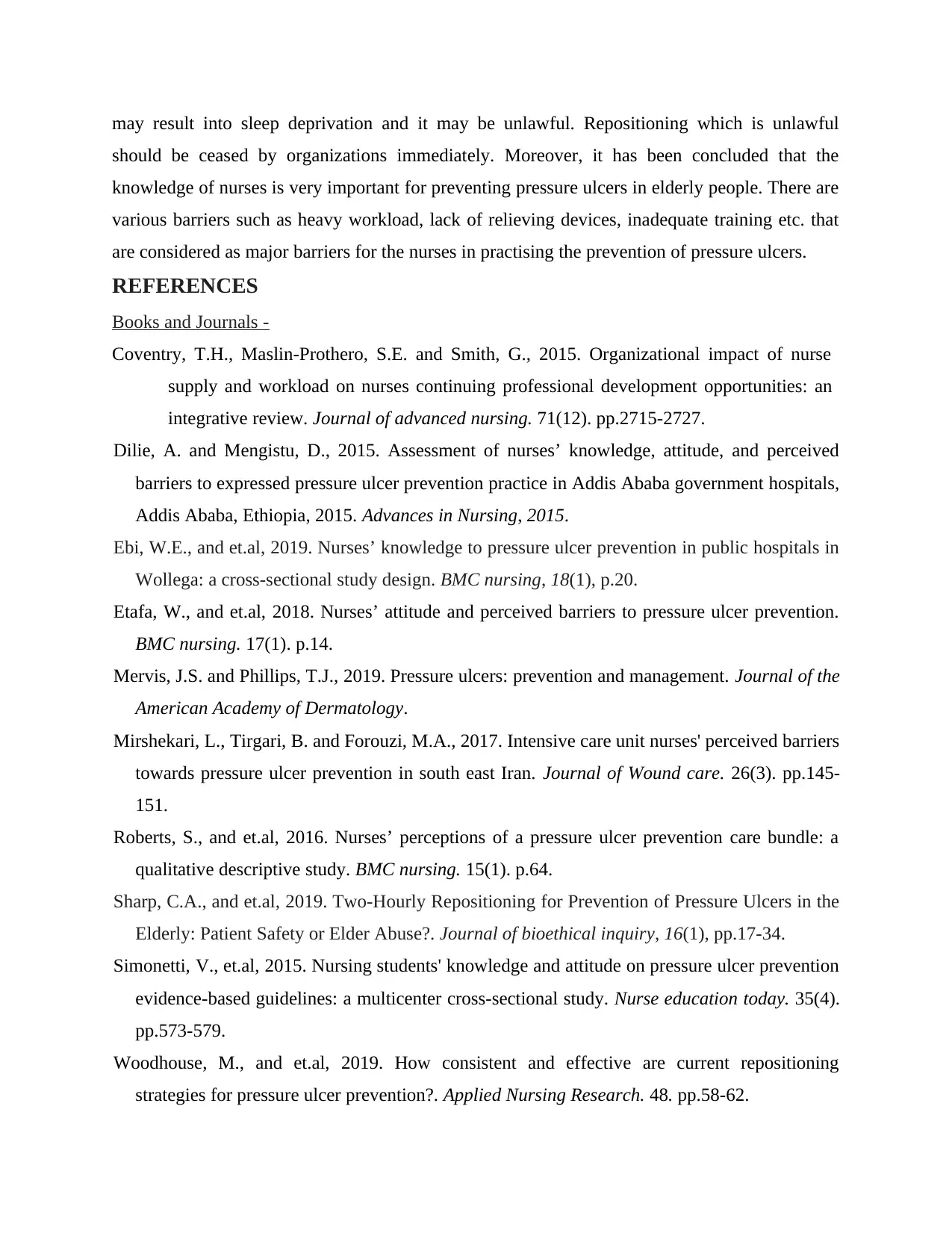
may result into sleep deprivation and it may be unlawful. Repositioning which is unlawful
should be ceased by organizations immediately. Moreover, it has been concluded that the
knowledge of nurses is very important for preventing pressure ulcers in elderly people. There are
various barriers such as heavy workload, lack of relieving devices, inadequate training etc. that
are considered as major barriers for the nurses in practising the prevention of pressure ulcers.
REFERENCES
Books and Journals -
Coventry, T.H., Maslin‐Prothero, S.E. and Smith, G., 2015. Organizational impact of nurse
supply and workload on nurses continuing professional development opportunities: an
integrative review. Journal of advanced nursing. 71(12). pp.2715-2727.
Dilie, A. and Mengistu, D., 2015. Assessment of nurses’ knowledge, attitude, and perceived
barriers to expressed pressure ulcer prevention practice in Addis Ababa government hospitals,
Addis Ababa, Ethiopia, 2015. Advances in Nursing, 2015.
Ebi, W.E., and et.al, 2019. Nurses’ knowledge to pressure ulcer prevention in public hospitals in
Wollega: a cross-sectional study design. BMC nursing, 18(1), p.20.
Etafa, W., and et.al, 2018. Nurses’ attitude and perceived barriers to pressure ulcer prevention.
BMC nursing. 17(1). p.14.
Mervis, J.S. and Phillips, T.J., 2019. Pressure ulcers: prevention and management. Journal of the
American Academy of Dermatology.
Mirshekari, L., Tirgari, B. and Forouzi, M.A., 2017. Intensive care unit nurses' perceived barriers
towards pressure ulcer prevention in south east Iran. Journal of Wound care. 26(3). pp.145-
151.
Roberts, S., and et.al, 2016. Nurses’ perceptions of a pressure ulcer prevention care bundle: a
qualitative descriptive study. BMC nursing. 15(1). p.64.
Sharp, C.A., and et.al, 2019. Two-Hourly Repositioning for Prevention of Pressure Ulcers in the
Elderly: Patient Safety or Elder Abuse?. Journal of bioethical inquiry, 16(1), pp.17-34.
Simonetti, V., et.al, 2015. Nursing students' knowledge and attitude on pressure ulcer prevention
evidence-based guidelines: a multicenter cross-sectional study. Nurse education today. 35(4).
pp.573-579.
Woodhouse, M., and et.al, 2019. How consistent and effective are current repositioning
strategies for pressure ulcer prevention?. Applied Nursing Research. 48. pp.58-62.
should be ceased by organizations immediately. Moreover, it has been concluded that the
knowledge of nurses is very important for preventing pressure ulcers in elderly people. There are
various barriers such as heavy workload, lack of relieving devices, inadequate training etc. that
are considered as major barriers for the nurses in practising the prevention of pressure ulcers.
REFERENCES
Books and Journals -
Coventry, T.H., Maslin‐Prothero, S.E. and Smith, G., 2015. Organizational impact of nurse
supply and workload on nurses continuing professional development opportunities: an
integrative review. Journal of advanced nursing. 71(12). pp.2715-2727.
Dilie, A. and Mengistu, D., 2015. Assessment of nurses’ knowledge, attitude, and perceived
barriers to expressed pressure ulcer prevention practice in Addis Ababa government hospitals,
Addis Ababa, Ethiopia, 2015. Advances in Nursing, 2015.
Ebi, W.E., and et.al, 2019. Nurses’ knowledge to pressure ulcer prevention in public hospitals in
Wollega: a cross-sectional study design. BMC nursing, 18(1), p.20.
Etafa, W., and et.al, 2018. Nurses’ attitude and perceived barriers to pressure ulcer prevention.
BMC nursing. 17(1). p.14.
Mervis, J.S. and Phillips, T.J., 2019. Pressure ulcers: prevention and management. Journal of the
American Academy of Dermatology.
Mirshekari, L., Tirgari, B. and Forouzi, M.A., 2017. Intensive care unit nurses' perceived barriers
towards pressure ulcer prevention in south east Iran. Journal of Wound care. 26(3). pp.145-
151.
Roberts, S., and et.al, 2016. Nurses’ perceptions of a pressure ulcer prevention care bundle: a
qualitative descriptive study. BMC nursing. 15(1). p.64.
Sharp, C.A., and et.al, 2019. Two-Hourly Repositioning for Prevention of Pressure Ulcers in the
Elderly: Patient Safety or Elder Abuse?. Journal of bioethical inquiry, 16(1), pp.17-34.
Simonetti, V., et.al, 2015. Nursing students' knowledge and attitude on pressure ulcer prevention
evidence-based guidelines: a multicenter cross-sectional study. Nurse education today. 35(4).
pp.573-579.
Woodhouse, M., and et.al, 2019. How consistent and effective are current repositioning
strategies for pressure ulcer prevention?. Applied Nursing Research. 48. pp.58-62.
⊘ This is a preview!⊘
Do you want full access?
Subscribe today to unlock all pages.

Trusted by 1+ million students worldwide
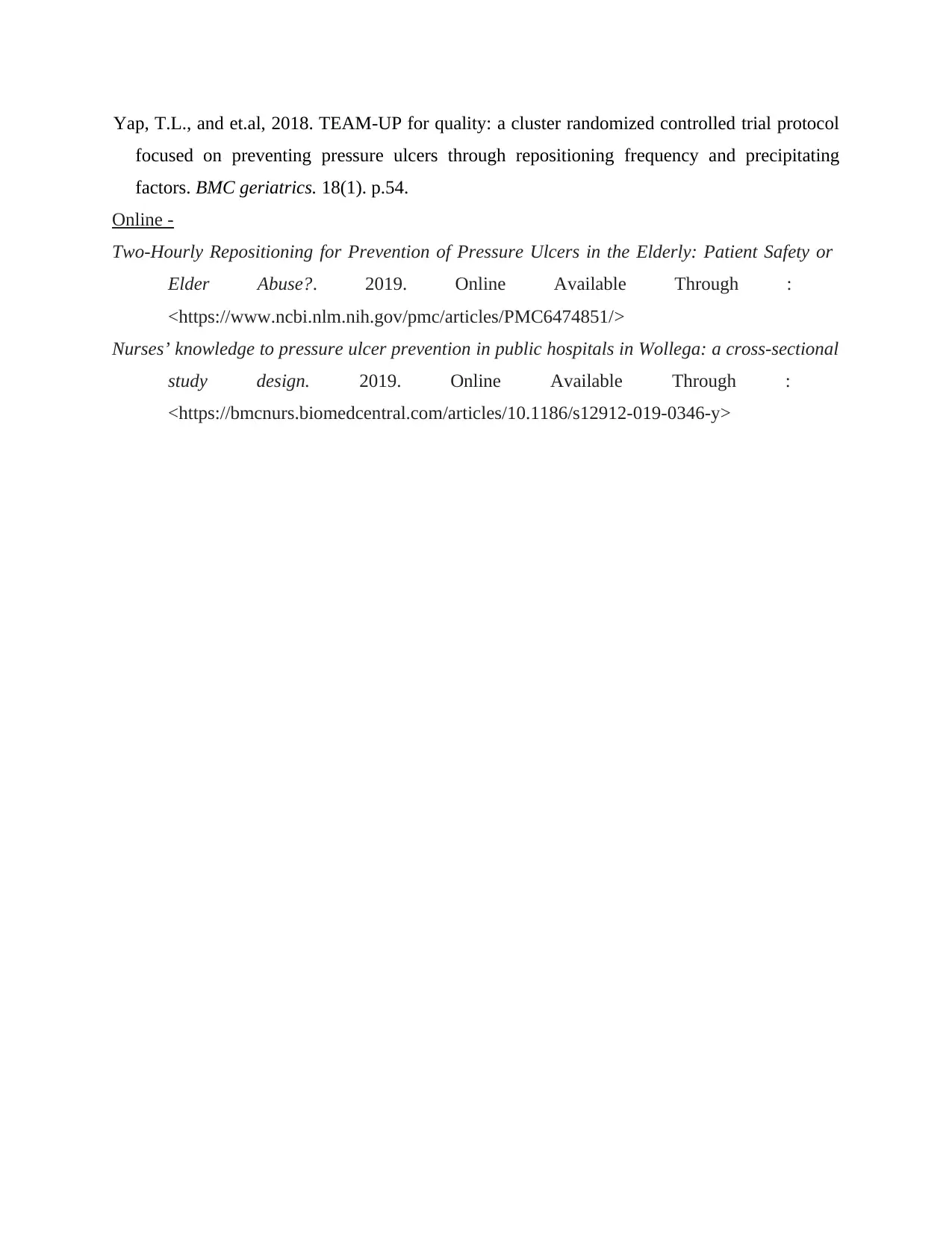
Yap, T.L., and et.al, 2018. TEAM-UP for quality: a cluster randomized controlled trial protocol
focused on preventing pressure ulcers through repositioning frequency and precipitating
factors. BMC geriatrics. 18(1). p.54.
Online -
Two-Hourly Repositioning for Prevention of Pressure Ulcers in the Elderly: Patient Safety or
Elder Abuse?. 2019. Online Available Through :
<https://www.ncbi.nlm.nih.gov/pmc/articles/PMC6474851/>
Nurses’ knowledge to pressure ulcer prevention in public hospitals in Wollega: a cross-sectional
study design. 2019. Online Available Through :
<https://bmcnurs.biomedcentral.com/articles/10.1186/s12912-019-0346-y>
focused on preventing pressure ulcers through repositioning frequency and precipitating
factors. BMC geriatrics. 18(1). p.54.
Online -
Two-Hourly Repositioning for Prevention of Pressure Ulcers in the Elderly: Patient Safety or
Elder Abuse?. 2019. Online Available Through :
<https://www.ncbi.nlm.nih.gov/pmc/articles/PMC6474851/>
Nurses’ knowledge to pressure ulcer prevention in public hospitals in Wollega: a cross-sectional
study design. 2019. Online Available Through :
<https://bmcnurs.biomedcentral.com/articles/10.1186/s12912-019-0346-y>
1 out of 10
Related Documents
Your All-in-One AI-Powered Toolkit for Academic Success.
+13062052269
info@desklib.com
Available 24*7 on WhatsApp / Email
![[object Object]](/_next/static/media/star-bottom.7253800d.svg)
Unlock your academic potential
Copyright © 2020–2025 A2Z Services. All Rights Reserved. Developed and managed by ZUCOL.





